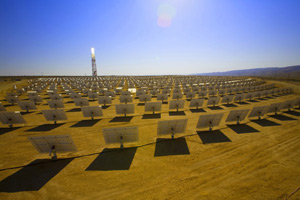Week in review: Solar booms into 2012 and beyond
 Last week the U.S. solar industry reported that the amount of newly installed solar power was 76 percent higher in 2012 than in 2011. And while that’s great for the industry, some states are having legislation introduced that would curtail the growth of solar—on purpose. Meanwhile the government approved some huge new projects in the desert southwest and two leading concentrating solar providers have partnered on one of the largest CSP plants ever. The PV market has been booming and now solar hot water is showing some signs of growth in the U.S. as well.
Last week the U.S. solar industry reported that the amount of newly installed solar power was 76 percent higher in 2012 than in 2011. And while that’s great for the industry, some states are having legislation introduced that would curtail the growth of solar—on purpose. Meanwhile the government approved some huge new projects in the desert southwest and two leading concentrating solar providers have partnered on one of the largest CSP plants ever. The PV market has been booming and now solar hot water is showing some signs of growth in the U.S. as well.
First off, solar is becoming an increasingly large part of U.S.’s generating power. Last week GTM Research and the Solar Energy Industries Association (SEIA) released their annual “U.S. Solar Market Insight: Year-in-Review 2012.” The report found that 3.3 gigawatts of new solar was added to the U.S. grid in 2012. It also projected that more solar would be added in 2013, with 4.2 gigawatts of PV and 940 megawatts of CSP expected to come online this year.
Meanwhile, the U.S.’s solar growth will be outshined in 2013 by a number of other countries. A new NDP Solarbuzz report found that worldwide 29 gigawatts of PV was installed and in 2013 it anticipated that 31 gigawatts of PV will be installed. In the past Germany has dominated the scene, but growth in installations in China will make it the largest market in 2013, the report said.
In some states, like Vermont and North Carolina, legislation has been introduced that could negatively impact solar growth. In Vermont, Senate Bill 30 would stop wind development for three years and add complexity to how solar and other renewable energy projects are developed in the states. The bill would also make getting such projects underway more expensive to ratepayers since it would add complexity and wasted time to the permitting process.
The proposed legislation in North Carolina could even be more damaging to solar and renewable energy goals in the state. N.C. House Bill 238 would eliminate the state’s renewable portfolio standard. The state’s solar advocacy organization North Carolina Solar Energy Association is strongly opposed to the legislation and said it will actually reduce the cost-savings that clean energy has already produced in the state. The state’s renewable portfolio standard has created 21,000 job-years and generated $1.7 billion in economic benefit for the state since 2007, it said.
But renewable energy keeps growing. Last week the Department of the Interior approved three new giant renewable energy projects: the McCoy Solar Energy Project; the Desert Harvest Solar Farm; and the Searchlight Wind Energy Project. Together they total 1.1 gigawatts of new clean energy in the desert southwest.
Such projects sometimes breed interesting partnerships. For instance, last week, two of the biggest CSP companies, Abengoa and BrightSource Energy partnered to develop, build and operate the 500 MW Palen Solar Power Project. The project was originally proposed by Solar Millennium but the company went bankrupt.
To stimulate more interest in solar hot water installations, Hawaii Energy increased its solar hot water rebates for homeowners. It recently announced that it increased its instant rebate on new solar water heating systems from $750 to $1,000. Solar hot water is also effective for communities or campus-type installations. For instance, Fellowship Square Tucson, a 615 unit retirement facility, is now sourcing roughly 85 percent of its water from 600 solar hot water collectors on its carports. The systems are providing residential hot water as well as heating for the campuses pools. The systems are coupled with 17,000 gallons of hot water storage and will dramatically reduce the community’s use of natural gas-fired boilers, saving the community money.



